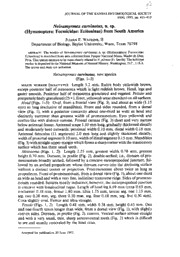
Neivamyrmex curvinotus n. sp. (HymenopteraL Formicidae: Ecitoninae) from South America. PDF
Preview Neivamyrmex curvinotus n. sp. (HymenopteraL Formicidae: Ecitoninae) from South America.
JOURNALOFTHE KANSAS ENTOMOLOGICALSOCIETY 66(4), 1993, pp. 411-413 Neivamyrmex curvinotus, n. sp. (Hymenoptera: Formicidae: Ecitoninae) from South America JULL\N F. WaTKINS, II Department ofBiology, Baylor University, Waco, Texas 76798 abstract: The worker ofNeivamyrmexcurvinotus, n. sp. (Hymenoptera: Formicidae: Ecitoninae)isdescribedfrom antscollectedfrom ParqueNacionalManu, MadredeDios, Peru.ThisspeciesappearstobemostcloselyrelatedtoN.pilosus(Fr.Smith).Theholotype workerisdepositedintheNationalMuseumofNaturalHistory,Washington,D.C.,U.S.A. Thequeenand male are unknown. Neivamyrmex curvinotus, new species (Figs. 1-3) MAJOR WORKER (holotype): Length 5.2 mm. Entire body yellowish brown, except posterior halfofmesosoma which is light reddish brown. Head, legs and gaster smooth. Posterior halfofmesosoma granulated and rugated. Petiole and postpetiolefinelygranulated(25x). Erect,yellowishsetaeabundantonallsurfaces. Head(Figs. 1-3): Oval, from a frontal view (Fig. 3), and about as wide (1.15 mm) as long (exclusive of mandibles). Front and sides rounded, from a dorsal view (Fig. 1), with a posterior concavity about one-third as wide as head and distinctly narrower than greatest width of promesonotum. Eyes yellowish and ocellus-like with distinct corneas. Frontal carinae (Fig. 3) short and very narrow mm belowantennal fossae. Antennal scape 1.10 long, graduallythickeneddistally and moderately bent outwards; proximal width 0.10 mm, distal width 0.18 mm. mm Antennal funiculus (11 segments) 2.0 long and slightly thickened distally; widthofproximalsegment0.10mm,widthofdistalsegment0.15 mm. Mandibles (Fig. 3)withstraightuppermarginwhichformsasharpcomerwiththemasticatory surface which has three small teeth. Mesosoma (Figs. 1, 2): Length 2.25 mm, greatest width 0.78 mm, greatest height 0.70 mm. Dorsum, in profile (Fig. 2), double-arched; i.e., dorsum ofpro- mesonotum broadly arched, followed by a concave mesopropodealjuncture, fol- lowed by an arched propodeum whose dorsum curves into the declining surface without a distinct comer or projection. Promesonotum about twice as long as propodeum. Frontofpromesonotum, from adorsal view(Fig. 1), aboutone-third aswideasheadandwithaveryfine, indistincttransverseridge. Sidesofpromeso- notum rounded. Sutures mostly indistinct; however, the mesopropodealjunction is concave with longitudinal rugae. Length ofhind leg 6.69 mm (coxa 0.65 mm, trochanter 0.18 mm, femur 1.80 mm, tibia 1.75 mm, tarsus: seg. one 1.15 mm, seg. two 0.38 mm, seg. three 0.30 mm, seg. four 0.18 mm, seg. five 0.30 mm). Coxa slightly oval. Femur and tibia straight. Petiole (Figs. 1, 2): Length 0.48 mm, width 0.38 mm, height 0.43 mm. One and one-fourth times longer than wide, from a dorsal view (Fig. 1), with slightly convex sides. Dorsum, in profile (Fig. 2), convex. Ventral surface almost straight and with a very small, thin, sharp anteroventral tooth (Fig. 2) which is difficult to see and usually concealed by the hind coxa. Accepted forpublication 30 June 1993. 412 JOURNAL OFTHE KANSAS ENTOMOLOGICALSOCIETY Figs. 1-3. Major worker (Holotype) ofNeivamyrmex curvinotus, new species. 1. Dorsal view of wholeantwithoutantennaeandlegs.2. Lateralviewofwholeantwithoutfuniculaandlegs.3. Frontal view ofhead without right funiculus. Scale line equals 1.0 mm. Postpetiole (Figs. 1, 2): Length 0.39 mm, width 0.43 mm, height 0.45 mm. Subquadrate, from a dorsal view (Fig. 1), with convex sides. Dorsum, in profile (Fig. 2), convex. Ventor almost straight. Tergostemal suture distinct. Gaster (Fig. 2): Length 1.60 mm, width 1.02 mm, height 1.0 mm. Oval with well developed, slightly curved sting. Sutures distinct. VARIATIONS: Major and minor workers are very similar. Body lengths vary mm from 2.5 to 5.5 and the smaller workers tend to be slightly lighter in color (yellowish brown) than the largerworkers (light reddish brown). Heads ofsmaller workers are more elongated and their antennal scapes are relatively longer. The masticatory surfaces of the mandibles are finely serrated (50x) on the smaller workers, but have three or four distinct teeth on the larger workers. DISTINCTIVEcharacteristics: Dorsum ofmesosoma, in profile, double-arched {""curvinotus"). Head oval with a posterior concavity that is about one-third as wideasheadandnarrowerthanthegreatestwidthofthepromesonotum. Mandible with a straight upper margin which forms a sharp comer with the masticatory surface. Petiole longer than postpetiole and with a convex dorsum. Petiole with a small, sharp anteroventral tooth. Color yellowish to light reddish brown. QUEEN AND MALE: Unknown. types: Workers with red determination labels and white locality labels. Col- VOLUME NUMBER 66, 4 4,3 lected by Donald Feener and Brian Brown, 28 February 1992, 1, 4 March 1992, Peru, Madre de Dios, Parque Nacional Manu, Pakitza. Holotype'and 6 paratypes deposited in the National Museum ofNatural History, Washington, D.C., U.S.A. Additional paratypes deposited in the American Museum of Natural History NewYork; Museum ofComparativeZoology, Harvard; Natural HistoryMuseum ofLos Angeles County; Watkins Collection, Baylor Univ., Waco, Texas. GECXJRAPHICAL DISTRIBUTION: Colombia, Meta; Peru, Madre de Dios. SPECIMENS EXAMINED (iV. cuKvinotus, n. sp.): Thirty-seven workers from the type locality collected by Donald Feener and Brian Brown on 28 February 1992 and 1, 4 March 1992. Twenty-five workers from PNN La Macarena, Meta, Co- lombia, collected by Edgard Palacio on 16 July 1992. Discussion Neivamyrmexcurvinotus, n. sp. belongstoBorgmeier's"GroupIII"(Borgmeier, 1955, p. 360) and its workers are most similar to those ofA^. pilosus (Ft. Smith)' however, they can be distinguished from workersofall the otherspeciesin Group III by their more arched propodea and more concave mesopropodealjunctions Workers ofN. curvinotus are yellowish brown to light reddish brown, whereas thoseofA^.pilosusareusuallydarkreddishbrowntoblack. Pinnedblackspecimens fadetoreddishbrownastheyage. WorkersofiV. curvinotuswillkeytoA^. impudem (Mann) in Watkins (1976); however, the node ofthe petiole ofA^. curvinotus is notflatteneddorsallyasstated incouplet 44b. Also, thedorsumofthepropodeum ofA^. curvinotus, in profile, is more arched and thelamella in front oftheantennal fossa is narrower. Acknowledgments Workers ofA^. curvinotus, n. sp. forthis studywere provided by Donald Feener UniversityofUtah, and Edgard Palacio, Santafede Bogota, Colombia. This study was supported by the Department ofBiology, Baylor University, Waco, Texas. Literature Cited Borgmeier. T. 1955. Die Wanderameisen der neotropischen Region (Hym. Formicidae) Studia Entomol., Nr. 3. 716 pp. Mann. W. M. 1922. Ants from Honduras and Guatemala. Proc. U.S. Nat. Mus. 61:1-54. Smith. F. 1858. Catalogue ofthe Hymenopterous Insects in the Collection ofthe British Mus VI 216 pp. Watkins. J. F. 1976. The Identification and Distribution ofNew World Armv Ants (Dorylineae- Formicidae). Baylor Univ. Press. Waco. Texas. 102 pp.
